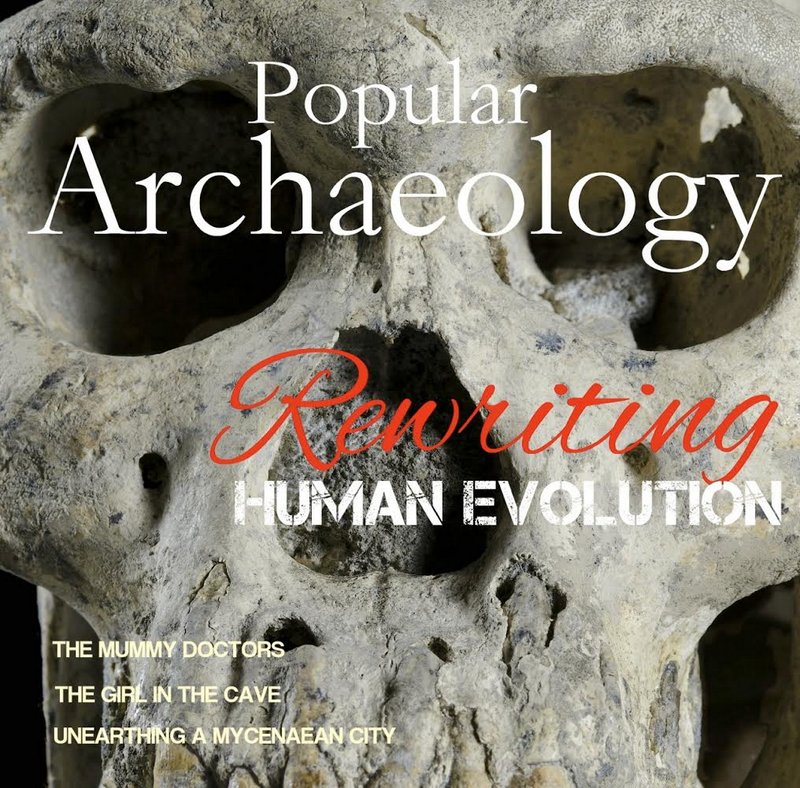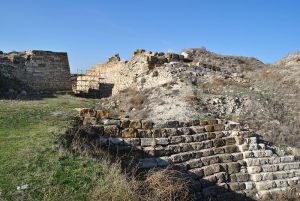
A team of archaeologists have unearthed new evidence of massive, monumental defensive works at the Citadel Mound site of ancient Gordion in Turkey. Excavations have also revealed ancient industrial activity dating back to the 11th century BCE.
Located about 70–80 km southwest of Ankara in western Turkey, Gordion, the ancient city best known as the residence of the legendary King Midas, has been the focus of on-and-off excavations since it was discovered in 1893 by Alfred Körte, who initiated exploratory excavations at the site in 1900. Now, Brian Rose of the University of Pennsylvania and colleagues have uncovered massive defensive walls, part of a road, and industrial work spaces dated back to some of the earliest periods of the site. During the early first millennium B.C., Gordion was the power center of the Phrygian kingdom, ruling much of Asia Minor. It was under King Midas and later rulers that the kingdom reached its apogee.
“Gordion’s historical significance derives from its very long and complex sequence of occupation, with seven successive settlements spanning a period of nearly 4500 years,” says Rose. “What we discovered was a large glacis or stepped terrace wall over 2.5 m in height, dating to the Early Phrygian period, that supported a substantial fortification wall nearly 3 m. wide. This had proven that the western side of the mound was fortified, and that those fortifications had already been established in the Early Phrygian period (9th c. B.C.), neither of which had been known previously.”*
Other massive fortifications, particularly on the eastern side of the Citadel Mound, were uncovered through previous expeditions. But in the last two seasons, beginning in 2013 under Rose’s renewed excavations at the south side of the Citadel Mound, solid new evidence has emerged for additional defensive works.
Most significantly, the excavations have also now revealed fortifications spanning the entire time period of Phrygian rule in the region. “We were fortunate this year in uncovering new fortifications dating to three different periods: Early Phrygian (9th c. BC), Middle Phrygian (8th c. BC) and Late Phrygian (6th c. BC)…….it is already clear that the scale of the citadel fortifications throughout the entire Phrygian period was much more ambitious than formerly suspected.”*
Additionally, Rose’s team excavated a sondage trench through what has been designated the Terrace Building, a structure discovered during previous excavations and thought to be a building where industrial activities occurred. They uncovered a large industrial kiln surrounded by ceramic remains that helped to date the feature to the Early Iron Age, or the 11th century BCE. Above and east of the kiln they excavated an Early Iron Age house structure, which contained objects related to textile manufacture, such as spindle whorls and loom weights, and a bell-shaped pit that contained fragments of Early Iron Age handmade wares and animal bones. “The evidence yielded by the sondage demonstrates that there was considerable industrial activity in this area before the Terrace Building was constructed, beginning in the 11th c. B.C.,” wrote Rose in a recent newsletter report.*
The Outer Town
Concurrent with the excavations and conservation efforts at Gordion, a team under the direction of Stefan Giese and Christian Huebner of GGH in Freiburg, Germany, has been conducting a geophysical survey of the ‘Outer Town’ using magnetometry and electric resistivity techniques. The Outer Town is a second residential area with detected remains just west of the Lower Town, another residential area that extends below the Citadel Mound. What they found has been no less revelatory than the Citadel Mound discoveries. They detected signs that the Outer Town was “bordered by a ditch with a defensive wall on its interior”*, which the team believes surrounded the entire Outer Town. The findings include other features that suggest a monumental fort. These preliminary finds are similar to those previously discovered in the Lower Town, which also features a defensive wall and ditch.
_________________________________
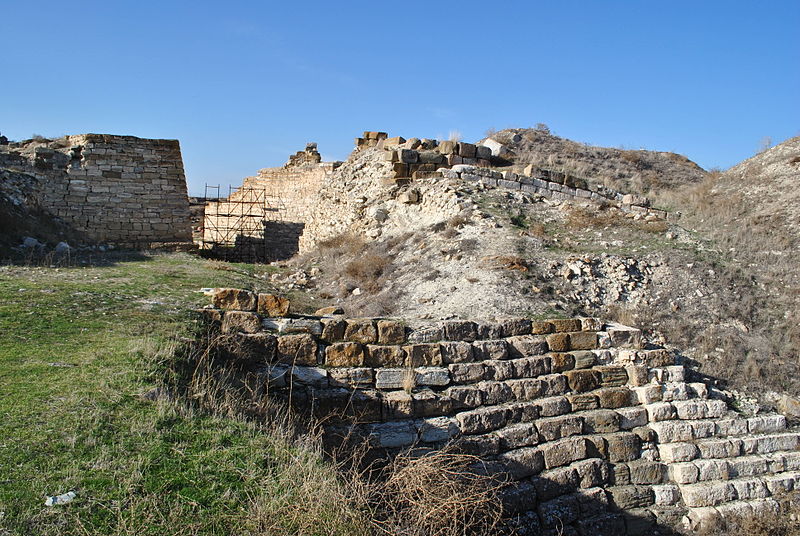 View of the Gordion Citadel Mound and previously excavated fortifications. Note the scaffolding at the Citadel Gateway in the background, a visible reminder of the ongoing architectural conservation and restoration work at the site. Vikicizer, Wikimedia Commons
View of the Gordion Citadel Mound and previously excavated fortifications. Note the scaffolding at the Citadel Gateway in the background, a visible reminder of the ongoing architectural conservation and restoration work at the site. Vikicizer, Wikimedia Commons
____________________________________________
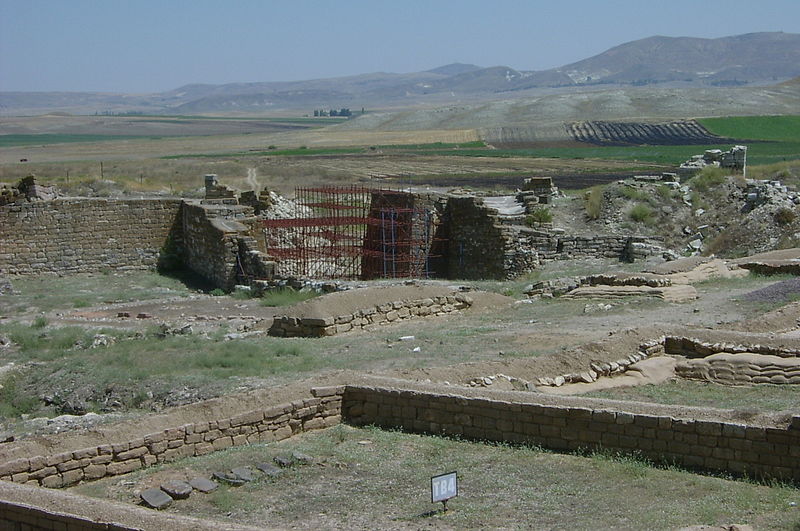 Elevated overview of the Citadel Mound area. Stipich Bela, Wikimedia Commons
Elevated overview of the Citadel Mound area. Stipich Bela, Wikimedia Commons
__________________________________________
Although archaeological excavations have taken place at Gordion over decades through a number of expeditionary endeavors, the best known excavations were conducted under the directorship of Rodney Young of the University of Pennsylvania Museum of Archaeology and Anthropology (Penn Museum) beginning in the 1950’s. His excavations over 17 seasons uncovered major sections of the Phrygian period Citadel Mound, including overlying Hellenistic towns, and a mudbrick fortress and defensive walls of a Lower Town near the Citadel. During the first years of his excavations, he encountered earlier Bronze Age settlement remains, but investigations of these levels were limited. Young also uncovered 30 burial tumuli, which included the sensational royal ‘Tumulus MM‘ (Midas Mound) and a nearby tomb of a wealthy Phrygian child (Tumulus P).
___________________________________
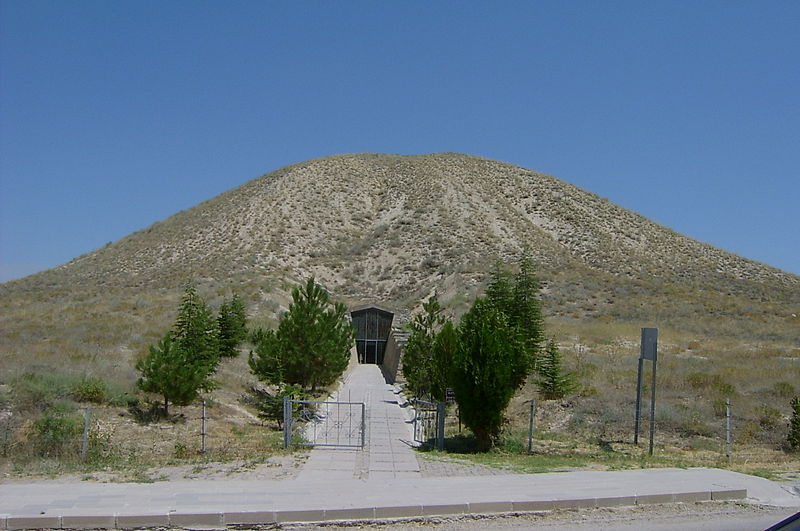 The Tumulus MM, showing entrance to the associated museum. Tipich Bela, Wikimedia Commons
The Tumulus MM, showing entrance to the associated museum. Tipich Bela, Wikimedia Commons
___________________________________
Rose will be continuing excavations at the site in 2015 and ensuing years under the auspices of the Penn Museum, efforts that have included extensive architectural conservation and restoration work, notably at the spectacular Early Phrygian Gate, considered the best preserved citadel gate of Iron Age Asia Minor.
“We have not yet determined the city plan of the settlement,” says Rose, “but by combining excavation with remote sensing (radar, magnetic prospection), we should be able to do it.”
More information about the Gordion Archaeological Project can be found at the website. In addition, an in-depth article about Gordion and the excavations will be published in the Winter 2014/2015 issue of Popular Archaeology Magazine.
____________________________________
* Rose, C. Brian and Gürsan-Salzman, Ayse, Friends of Gordion Newsletter, September 2014
____________________________________________
Just released!
The special new premium quality print edition of Popular Archaeology Magazine. A beautiful volume for the coffee table.
Travel and learn with Far Horizons.
Read about the most fascinating discoveries with a premium subscription to Popular Archaeology Magazine. Find out what Popular Archaeology Magazine is all about. AND MORE:
On the go? Get the smartphone version of Popular Archaeology as an app or as an ebook.
Popular Archaeology’s annual Discovery Edition eBook is a selection of the best stories published in Popular Archaeology Magazine in past issues, with an emphasis on some of the most significant, groundbreaking, or fascinating discoveries in the fields of archaeology and paleoanthropology and related fields. At least some of the articles have been updated or revised specifically for the Discovery edition. We can confidently say that there is no other single issue of an archaeology-related magazine, paper print or online, that contains as much major feature article content as this one. The latest issue, volume 2, has just been released. Go to the Discovery edition page for more information.

